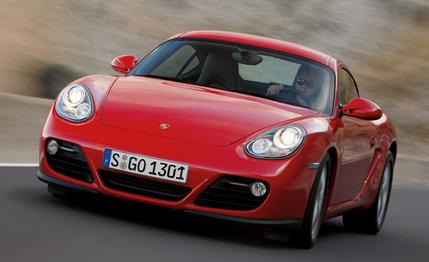
 Short Take Road Test
Short Take Road Test
The kids have moved out of the house, your hair isn’t turning any less gray, and a midlife crisis is swiftly approaching. Regrettably, the 911 you’ve always dreamed of is just out of reach by way of the economy’s downturn. So how can you satisfy your Porsche lust? Have no fear—another one of the best sports coupes in the world comes from the same Stuttgart family, and it’s more affordable, too.


Going against most coupe-and-convertible pricing strategies, wherein the roofless versions are priced higher than the hardtops, the Cayman hit the streets for 2006 with an elevated base sticker compared with that of its Boxster sibling. Porsche’s current argument for that arrangement is that the Cayman is a better performer, as it weighs less and has more structural stiffness provided by its hardtop and the engines it shares with the Boxster are tuned for more power. For 2009, the Cayman receives its first freshening, with the base model offering an enlarged flat-six, an optional seven-speed dual-clutch automated manual transmission (PDK in Porsche-speak), and other various tweaks. But one thing remains unchanged: The Cayman is still at the top of its game.
Small Refinements
It’s hard to tell the 2009 Cayman apart from earlier versions, but it’ll be easy to see the new LED running lights up front, flanked by repositioned fog lights that are now found along the outer edge of the front air intakes. Out back, look for the LED treatment on the taillights, which now scallop into the rear fascia.
Inside, little has changed with the exception of the new monochromatic infotainment display on base Caymans, which happens to be our only real gripe about the car. The screen is a nice thought, but the interface is so low-rent, it looks as if it were powered by MS-DOS. Thankfully, the standard sound system includes an auxiliary input and sounds like it was engineered this century.
Revised Engine, Revised Power
Under the skin is where the major changes take place, beginning with the heart of the Cayman. Up 0.2 liter from the previous engine, the new 2.9-liter flat-six develops 265 hp at 7200 rpm and 221 lb-ft of torque from 4400 to 6000 rpm. Those are increases of 20 hp and 20 lb-ft of torque, thanks to a boost in compression and Porsche’s variable valve-lift and -timing system on both exhaust and intake cams. On the street, the bottom end still lacks the grunt of the 320-hp, 3.4-liter direct-injected flat-six in the Cayman S, but the base engine winds up quickly while blurting out a rorty exhaust note. On the track, the enhancements translate to an impressive 5.1-second run to 60 mph and a 13.7-second quarter-mile at 102 mph with our PDK-equipped car. For perspective, that makes this Cayman 0.4 second quicker to 60 than the last 2.7-liter Cayman and nearly equivalent to the pre-2009 Cayman S we tested, both of which were fitted with a manual transmission.
My Transmission Is Smarter than Your Honor Roll Student
Speaking of transmissions, opting for the PDK ($3420) can sweeten the deal for those who not so well versed with a conventional six-speed—now standard on all Caymans—and even those who are. PDK can be left in full-automatic mode, or you can manually rip off rapid shifts via the shift lever or steering-wheel buttons. Yes, we’ve expressed our discontent with the awkward pull/push button setup, but Porsche has announced an optional steering wheel for the 911 Turbo that solves the problem with real paddles, and we expect them to be offered on the rest of the company’s sports cars soon. Paddles aside, PDK is quite possibly the best twin-clutch transmission offered on any mass-produced car. It’s incredibly responsive and able to make super-fast multigear downshifts. And if you and your Cayman plan to hit the track, we’d strongly suggest opting for the Sport Chrono Package Plus that adds a race calibration setting to the PDK and revises and optimizes shift points. We’ve experienced it firsthand on the track at Barber Motorsports Park, and the difference is clearly noticeable.
PDK doesn’t only help improve performance numbers; it aids fuel economy, as well. With the seventh gear specifically added for economy purposes, PDK helped our Cayman return 23 mpg overall.
Chassis Changes
Porsche says it refined the suspension tuning for 2009, but we can attest that the Cayman has retained the stellar handling and steering feel we have come to love. The Cayman continues to provide the same confident stability at any speed, even without the optional Porsche Active Suspension Management. Porsche says that revised Michelin PS2 tires allow for lower pressures in the rear, aimed at enhancing the ride comfort, but they don’t forfeit grip or stability, maintaining a sticky 0.96 g on the skidpad. The base Cayman’s front brakes have been upgraded to match those on the Cayman S; the rears are of the same diameter as those on the S but are thinner. Stopping distance improved to 151 feet from 70 mph, four feet better than the last non-S Cayman we tested.
With driving dynamics mimicking—and sometimes besting—those of the gold-standard 911, along with a base price $26,000 lower than the 911’s, it’s unwise not to give this improved mid-engine coupe some serious thought. Although the 911 is often considered the quintessential sports car, the Cayman still carries two golf bags in its hatch and gives up little to the 911 aside from a pair of useless back seats. Midlife crisis or not, the Cayman remains near the top of our wish list.